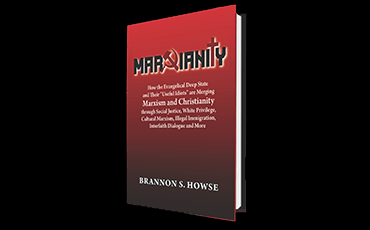Ecumencialism Is one of the Four E's Building The Coming Religious Reich
By Brannon S. Howse
On October 26, 2011, I spent an entire hour on my radio program explaining why I believe the coming religious Reich will built on the four E’s of ecumenicalism, economics, education, and environmentalism. Watching what has unfolded since then causes me to be more convinced than ever that this is occurring. While certainly not exhaustive, let me give you a brief understanding of how the four Es will help build the religious Reich.
Ecumenicalism
The Vatican Council II was in session from 1962 to 1965 and is thought by many to be the catalyst for the modern ecumenical movement that today has just about succeeded in merging the world’s false religions. Ecumenicalism has and will continue to be one of the four E’s that builds the religious Reich.
Please understand that I have no animosity toward individual Roman Catholics. I desire that anyone deceived by the false teachings of the Church of Rome be set free through the loving and consistent presentation of the glorious message of the true Gospel. Some of my closest friends were once Catholics who now share a heart for bringing the Gospel to those inside and outside the Church of Rome. Most people who call themselves “Catholic” have little grasp of the church’s history.
Men who started the Great Reformation were themselves Catholic who studied the Bible and recognized the false gospel of the Church of Rome. This includes people like John Wycliffe, William Tyndale, and of course, Martin Luther, who was a Catholic priest. While this chapter focuses heavily on the Church of Rome, I believe the vast majority of the Protestant denominations have embraced another Jesus and another gospel as well, so the woman that rides the beast will not consist exclusively of people within the Church of Rome. Catholicism may be a major leader of false world religion, but the harlot will include many others who have attended or do attend some of the world’s most well-known Protestant churches—and I am not speaking only of mainline, liberal churches.
John O’Malley, a professor at Georgetown University and a Jesuit priest, is the author of What Happened at Vatican II, and in a 2012 column in the New York Times, he describes how Vatican II encouraged the world’s religions to merge:
[quote] Before the council, Catholics were not only forbidden to pray with those of other faiths but also indoctrinated into a disdain or even contempt for them. (This was, of course, a two-way street.) Now, for the first time, Catholics were encouraged to foster friendly relations with Orthodox and Protestant Christians, as well as Jews and Muslims, and even to pray with them…. The change is also felt at the grass roots. Two years ago, I taught a doctoral seminar on Vatican II to six students: one Catholic, one Jew, two Protestants and two Muslims. I have officiated at weddings alongside rabbis and Methodist pastors. Catholic colleges and universities now as a matter of course have rabbis, imams and Protestant ministers on their campus ministry staff. [end quote]
However, the goal of the Vatican Council II was not so much about political correctness and pluralism but about bringing the world’s religions together under the control and influence of the Vatican.
Former Catholic Priest Salvatore Gargiulo explains the danger this poses:
[quote] Some evangelicals think that times have changed and that it is now possible to hold a dialogue and to collaborate with the Roman Catholic Church to achieve Christian unity. This is a deception of Satan. The doctrines of this ecclesiastical organization have in no way changed. In fact they are now adding new errors to the old ones, and in particular they are working towards bringing in all the other religions. The Vatican Council II document Nostra Aetate (1965), for example, says in paragraph 2: “Buddhism in its various forms testifies to the essential inadequacy of this changing world. It proposes a way of life by which man can, with confidence and trust, attain a state of perfect liberation and reach supreme illumination either through his own efforts or by the aid of divine help….The Catholic Church rejects nothing of what is true and holy in these religions.” [end quote]
This one world religious system will be a mixture of mysticism, paganism, and occultism can be traced back to the Tower of Babel. Roman Catholicism attempts to turn all the world’s religions back to Rome—and in doing so will aid in building the religion headquartered in actual Babylon. According to M. Basil Pennington, a prominent Catholic priest, the Vatican Council urged “all Christians . . . to act positively to preserve and even promote all that is good in other religions: Hinduism, Buddhism, and other world religions.” And Monseignor Wojtyla [who became Pope John Paul II] declared:
[quote] Nostalgia for the unity of Christians makes common cause with that of unity for the whole human race. … This gives rise to the attitude of the Church towards the other religions, which is based on the recognition of their spiritual values, humans and Christians together, reaching out to such religions as Islam, Buddhism, Hinduism.
Later, as Pope John Paul II, he proclaimed:
[quote] It is necessary for humanity to achieve unity through plurality, to learn to come together in the one Church, even while presenting a plurality of ways of thinking and acting, of cultures and civilizations. [end quote]
In an example of the extreme to which this “plurality” can reach, on February 5, 1993, the Los Angeles Times reported that during his 1993 tour of Africa, the pope “sought common ground with believers in voodoo . . . suggesting that they would not betray their traditional faith by converting to Christianity.” Pope Paul VI said:
[quote] The Church has this exhortation for her sons and daughters: prudently and lovingly, through dialogue and collaboration with the followers of other religions, and in witness of Christian faith and life, acknowledge, preserve and promote the spiritual and moral goods found among these peoples. [end quote]
At the universities of Calcutta and New Delhi in his 1986 visit to India, John Paul II also told Hindu audiences:
[quote] India’s mission. . . is crucial, because of her intuition of the spiritual nature of man. Indeed, India’s greatest contribution to the world can be to offer it a spiritual vision of man. And the world does well to attend willingly to this ancient wisdom and in it to find enrichment for human living. [end quote]
Similarly, Thomas Keating and Basil Pennington, both Catholic priests, stated in their book, Finding Grace at the Center:
[quote] We should not hesitate to take the fruit of the age-old Wisdom of the East and “capture” it for Christ. . . . Many Christians who take their prayer life seriously have been greatly helped by Yoga, Zen, TM and similar practices. [end quote]
The vision is spreading widely. New Jersey and New York area Catholic schools utilize a program titled Energetics for Living: A Curriculum Enhancement Program for Peace Education, developed by Sister Vergilla, and Jim and Claire Langie. Its purpose is:
[quote] “nothing less than the transformation of the child from within” through contact with the creative “energy” found “at the very center of their being” leading to an experience of “the interconnectedness and interdependency of all living creatures.”… Contact with the child’s “sacred center” is effected through “the regular practice of meditation, visualization, relaxation, breathing, etc.” “They have adapted the Hindu greeting “Namaste,” which means “The God in me greets the God in you!” Once the student sees that he and everything is God, “who would do violence to God or to any of his creatures?” asks Sister Loretta Carey, R.D.C. of Fordham University.” Sister Mary L. O’Hara, C.S.J., professor of philosophy at the College of Saint Mary, Omaha, specializes in promoting Buddhist and Hindu techniques for enhancing education in Catholic schools. [end quote]
A “new” faith is emerging that is not new at all. It is, in fact, the same lie Satan presented in the Garden of Eden when he said, “You shall be as God.” Emerging all over the globe, this belief holds that sinful man can be “as God.” The worldview on which it is based is founded in the New Age Movement (Cosmic Humanism), Mormonism, the Emergent Church, the Word of Faith, the New Apostolic Reformation, Buddhism, Hinduism, and Roman Catholicism.
To facilitate this syncretism, the Church of Rome is willing to become all things to all religions in order to turn every major religion back to Rome. My friend and Worldview Weekend speaker, the late Dr. Ron Carlson, traveled to more than 90 countries on six continents, and he told me numerous times that he personally witnessed the Church of Rome embracing the prominent religions of various countries.
The views of New Age spokesperson Alice Bailey coordinate nicely with Rome’s efforts. She believes the new world religion should “rest upon the foundation of a newly interpreted and enlightened Christianity . . . being universal in nature.” She was pleased to see the United Nations promoting this new universal faith—now known as the New Spirituality—“based upon those truths which have stood the test of the ages…they are steadily taking shape in human thinking, and for them the United Nations fights.”
Teilbard de Chardin (Robert Muller’s mentor, as you’ll recall) echoes Bailey’s message: “The fate of mankind, as well as of religion, depends upon the emergence of a new faith in the future.”
Catholicism is right in step with Bailey, Muller, and de Chardin. In Geneva, addressing the World Council of Churches, John Paul II declared: “From the beginning of my ministry as bishop of Rome, I have insisted that the engagement of the Catholic Church in the ecumenical movement is irreversible.”
Mother Teresa even added her voice to the ecumenical campaign when she claimed:
[quote] If in coming face to face with God we accept Him in our lives, then we . . . become a better Hindu, a better Muslim, a better Catholic, a better whatever we are . . . .What God is in your mind you must accept. [end quote]
In 1985, Pope John Paul II declared, “Christians and Moslems, we meet one another in faith in the one God. . .[and] strive to put into practice . . .the teaching of our respective holy books.”
But Pope Boniface VIII stated in a papal decree:
[quote] There is one holy Catholic and apostolic church, outside of which there is no salvation…. it is altogether necessary for salvation for every creature to be subject to the Roman Pontiff.” Peter is the head of the church and “his successors [the popes]. [end quote]
And Karl Keating, a leading Catholic lay apologist, speaks of the individual’s role:
[quote] The Catholic believes in inspiration because the Church tells him so—that is putting it bluntly—and that same church has the authority to interpret the inspired text. Fundamentalists have no interpreting authority other than themselves. [end quote]
The Convert’s Catechism of Catholic Doctrine goes even further:
[quote] Man can obtain a knowledge of God’s Word from the Catholic Church and through its duly constituted channels. When he has once mastered this principle of divine authority, the inquirer is prepared to accept whatever the divine Church teaches on faith, morals and the means of grace. [end quote]
The most important thing Christians can do is to study and understand biblical truth. The quest to comprehend biblical truth trumps everything else. For the mature Christian, the goal is to understand the times in light of Scripture so we can be involved in worldview evangelization, contend for the faith, expose every high and lofty thing lifted up against the principles of the Lord, and occupy until the Lord returns. Whether adults, teenagers, or college students, Christians need to turn people from every perpetrator of one-world spirituality to the Truth of the one way.
Copyright 2015 ©Brannon Howse. This content is for Situation Room members and is not to be duplicated in any form or uploaded to other websites without the express written permission of Brannon Howse or his legally authorized representative.




